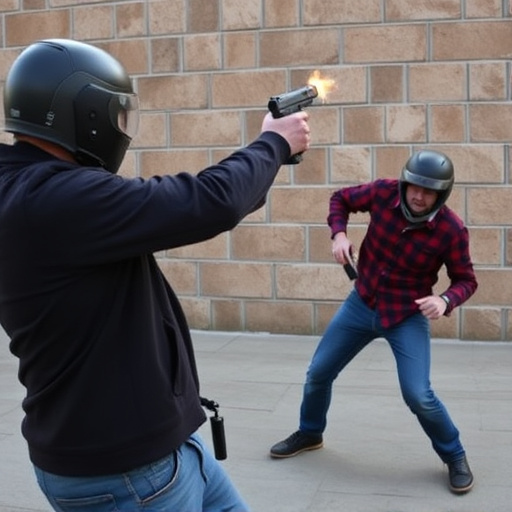Taser vs Stun Gun: Unraveling Key Differences for Wholesale Dealers
Understanding Tasers vs Stun Guns is crucial for wholesale bulk stun gun dealers aiming to serve div…….
Understanding Tasers vs Stun Guns is crucial for wholesale bulk stun gun dealers aiming to serve diverse customer needs. While both disable targets non-lethally, Tasers use electric arcs between two tips and require training, offering longer range and multiple pulse settings. Stun guns, easier to operate, deploy high-voltage pulses through metal probes often coated in capsaicin. This knowledge allows dealers to provide informed options for personal protection, law enforcement, or security professionals seeking safe, non-lethal force tools.
“Unraveling the differences between Tasers and stun guns is crucial for those in law enforcement, self-defense enthusiasts, or wholesale dealers. This article serves as a comprehensive guide, breaking down key distinctions in three parts.
First, we explore the chemical composition and functionality of each, revealing how they differ in range, effectiveness, and impact. Then, we delve into legal considerations surrounding their use, offering insights for responsible ownership. Finally, for wholesale bulk stun gun dealers, we provide an extensive overview of product types, benefits of bulk purchasing, and essential safety features.”
Taser vs Stun Gun: Understanding the Key Differences

When comparing Tasers and stun guns, it’s essential to understand their distinct functionalities and applications. While both devices utilize electrical current to incapacitate targets, they differ significantly in design, power output, and deployment strategies. Tasers, a brand name for conduction-based electronic control devices (ECDs), fire two small probes connected to wires, delivering an electric pulse that disrupts muscle control, causing temporary immobilization. In contrast, stun guns, or electroshock weapons, use high-voltage, low-current electrical discharge to override the body’s nervous system, resulting in a powerful but localized shock.
For wholesale bulk stun gun dealers, recognizing these differences is crucial for catering to diverse customer needs and preferences. Stun guns are generally more accessible and require less training to operate due to their straightforward design. In contrast, Tasers often demand specialized training and certifications, offering advanced features like longer range, multiple pulse settings, and increased safety mechanisms. Understanding these variations enables dealers to provide informed options for personal protection, law enforcement, or security professionals seeking effective yet safe non-lethal force tools, especially when considering wholesale bulk stun guns for dealers’ inventories.
– Chemical Composition and Functionality

Tasers and stun guns are both non-lethal weapons designed to incapacitate individuals, but they operate on different principles and use distinct chemical compositions. At their core, both devices rely on electrical current to disrupt muscle control, leading to temporary paralysis. However, the primary difference lies in their functionality and the chemicals employed.
Stun guns typically utilize high-voltage, low-amperage electrical pulses delivered through metal prongs or probes that make contact with the target’s body. These weapons often contain a high concentration of active ingredients like capsaicin (the chemical that makes chili peppers spicy) or other irritants in their projectiles. In contrast, tasers use electric arcs to create a powerful current that passes between two probe tips, affecting nerve impulses and causing muscle spasms. Tasers often employ a mix of chemicals, including potassium chloride and other active substances, stored in cartridges that are fired towards the target. For wholesale bulk stun guns for dealers, understanding these differences is essential when curating a diverse inventory to meet various customer needs and preferences.
When considering wholesale bulk stun guns for dealers, understanding the subtle yet significant differences between Tasers and stun guns is crucial. While both devices serve as non-lethal force tools, their chemical compositions and functionalities diverge. Tasers use a combination of chemicals to disrupt muscle control, whereas stun guns employ high-voltage electrical impulses. Each has its advantages, and dealers should weigh these factors to offer customers the most suitable option for their security needs.


